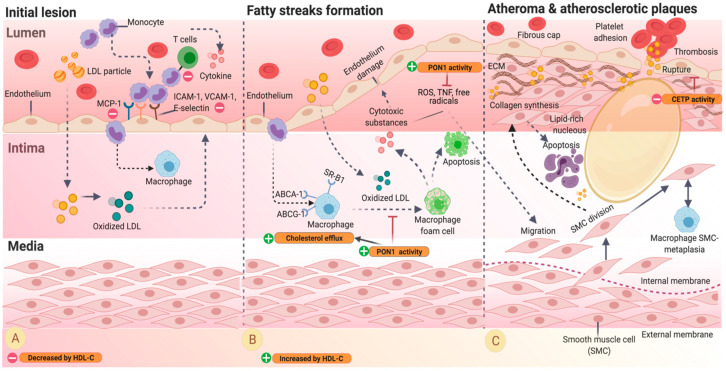Figure 1.
Progression of atherosclerosis adapted from [19,40,41,42]. (A) The excess of LDL-C particles in the vascular endothelium results in the internalization of lipids in the intima, which are oxidized, stimulating local activating leukocyte migration to the intima. Oxidized LDL-C triggers adhesion molecules, including ICAM-1, VCAM-1, E-selectin, and MCP-1 in the endothelial cells during the first steps of the lesion. HDL-C inhibits the expression of adhesion molecules (VCAM-1, ICAM-1, E-selectin) (orange rounded rectangle and green plus sign). (B) After penetrating the arterial wall, monocytes uptake ox-LDL, and form a macrophage foam cell, contributing to the formation of lipid streaks. HDL-C inhibits the oxidation of ox-LDL through the activity of PON1. (C) Cytotoxic substances stimulate smooth muscle cells (SMC) migration into the intima where it is divided to synthesize collagen, and the extracellular matrix (ECM) creates a fibrous cap and stabilizes the plaque. HDL-C decreases CETP activity, which improves the stability of the plaque and to avoid the formation of thrombus. Abbreviations: LDL-particle, low-density lipoprotein particle; ICAM-1, intercellular adhesion molecule 1; VCAM-1, vascular adhesion molecule 1; MCP-1, macrophage chemoattractant protein 1; ABCA-1, ATP-binding cassette transporter A member 1; ABCG-1, ATP-binding cassette transporter G member 1; SR-B1, scavenger receptor class B type 1; ROS, reactive oxygen species; TNF, tumor necrosis factor; SMC, smooth muscle cells.

